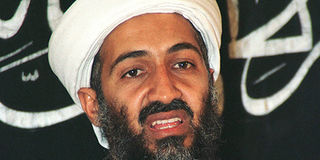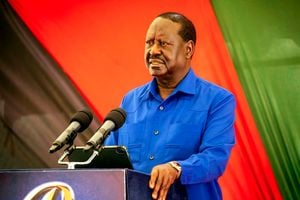We gave Osama playground; he rewarded us with bombs

Al Qaeda leader Osama bin Laden speaks at a news conference in Afghanistan in this May 26, 1998 file photo. Most Kenyans first heard the name Osama bin Laden in the days following the 1998 US Embassy bombings. PHOTO/REUTERS
What you need to know:
- Award-winning book says as a teenager chief terrorist came to hunt big game
Most Kenyans first heard the name Osama bin Laden in the days following the 1998 US Embassy bombings.
But the young bin Laden was a frequent visitor to Kenya long before the attacks, having come as a teenager to indulge in big game hunting and horse racing. He may also have visited when he sought refuge in Sudan in the 1990s after he was kicked out of Afghanistan.
This is one of the revelations in The Looming Tower: Al Qaeda’s Road to 9/11 by American journalist Lawrence Wright.
The book won the Pulitzer Prize in 2007 for its detailed examination of the events leading up to the attacks on the Twin Towers in New York in September 2001.
Kenya’s central place in the modern history of terrorism – the bombings in Nairobi were al Qaeda’s first major attack on western targets – is examined, offering surprising bits of information.
Mr Wright interviewed some of bin Laden’s childhood friends who described him as a quiet young man who enjoyed fast driving and cowboy movies.
“He had an adventurous adolescence – mountain climbing in Turkey and big game hunting in Kenya (before sport hunting was banned in 1977). On his family farm south of Jeddah, Osama kept a stable of horses, having as many as 20 at one time, including his favourite, a mare named al-Baqa. He liked to ride and shoot, just like the cowboys on his favourite television shows.”
The book also offers one of the most revealing biographies of bin Laden, tracing his transition from a relaxed and quiet young man to a radical whose sole mission was to wage Jihad against the Americans.
Osama’s father, Mohammed bin Awahd bin Laden, was brought up in the Horn of Africa. He was born in a small town in central Yemen, a country to the North of Somalia.
Mohammed bin Laden’s tribe was driven out of Yemen by a severe drought when he was a teenager. Mohammed moved first to Ethiopia , then to Saudi Arabia, at 21.
That was the country where he would make his name and build a fortune for his family. He caught the eye of the royal family as a hardworking constructor and was given the task of building a ramp for the ageing King Abdul Aziz.
“When Mohammed finished the job (building the ramp, for example), he personally drove the king up the ramp to show it could support his weight. In gratitude, the king awarded him the right to build several new palaces, including the first concrete building in Riyadh.”
Mohammed also won the contract to build two of the most revered mosques in Islam, the Grand Mosque in Mecca and the Al Aqsa mosque in Jerusalem.
He is described as a strict and disciplined man, although he had a weakness for women. He married 22 women with whom he had 54 children. Mohammed’s 17th son was named Osama bin Laden. Osama means “the Lion,” and was the name of one of the Prophet Mohammed’s companions.
Osama was born to Alia, a 14-year-old girl from Syria. When Osama was a toddler, Mohammed divorced Alia, and she was married by one of his workers in the construction firm, Mohammed al-Attas. While Osama loved television, movies and game hunting as a boy, he changed suddenly in his late teens.
This change has been ascribed to his charismatic Syrian high school gym teacher who was a member of the radical Islamist group Muslim Brothers.
He stopped wearing western dress outside school and would sometimes sit weeping in front of the television as he watched news about the Israeli occupation of Palestine.
Osama went off to university to study economics, but he had little interest in education. He concentrated on religious affairs and was particularly influenced by Sayyid Qutb, an Egyptian scholar who is seen as the ideological father of modern Islamic extremism.
After completing his studies, Osama, like most of his brothers, gravitated to the family firm. But he was not particularly interested in the business. He felt his true calling was Jihad.
And he got the chance to take part in the struggle when the Soviet Union invaded Afghanistan in December 1979.
Osama set off to help the Afghan Taliban fight the Soviets. He primarily played a role as financier, having been described by colleagues as being very fearful of physical participation on the battlefield.
It was in Afghanistan that Osama came under the decisive influence of Sheikh Abdullah Azzam, a Palestinian cleric, a “warrior priest” whose doctrine was “Jihad and the rifle alone; no negotiations, no conferences, no dialogues.”
Sheikh Azzam’s sermons inspired Osama and a group of radicals to set up al Qaeda in Afghanistan some time in 1987.
Al Qaeda worked with the Taliban to drive the Soviets from Afghanistan in 1989. But that victory only sharpened their hunger for greater victories.
When Osama returned to Saudi Arabia, he got into trouble with authorities for his criticism of the king’s support of the US invasion of Iraq in 1991.
Looking for a new base, he turned to Sudan, where Islamists led by Omar Hassan al Bashir and Hassan el Turabi, had taken over in June 1989. Osama viewed Sudan as a perfect setting for his activities and it offered what was the “happiest period of his life”.
He indulged his love for horse racing while cultivating contacts to further the cause of Jihad.
“In Sudan (horse racing events are) wild and boisterous, given to dancing and singing. The famous Mujahid (Osama) would plug his ears with his fingers whenever the band played. When he asked people to stop singing, they told him to get lost,” Wright writes.
“Music is the flute of the devil,” he is reported to have retorted.
It was while in Khartoum that Osama planned one of his most murderous acts, the embassy bombings in Nairobi and Dar es Salaam.
The plot started as early as 1993, when he sent several extremists to scout potential targets in Kenya, Djibouti, Tanzania and Senegal.
Osama knew Kenya from his earlier visits. The presence of many western targets made the country an obvious choice for Osama’s jihad against the Americans and their allies.
One of the jihadists dispatched to Kenya to survey targets, an Egyptian-born American named Ali Mohammed, would later tell a US court how Osama pointed out where he wanted the bomb that would rip through the US Embassy in downtown Nairobi placed.
“I took pictures, drew diagrams and wrote a report,” Mohamed said, describing how he later travelled to Sudan, where bin Laden and top advisers reviewed his “surveillance files”.
“Bin Laden looked at a picture of the American Embassy and pointed to where a truck could go (a spot at the back of the embassy),” Mohamed said.
The attack eventually went ahead at 10.34 a.m. on August 7, 1998. With it, Osama entered the world’s consciousness as one of the most notorious modern-day terrorists.
It was ironic that his journey into infamy properly began in Kenya, a land he had once loved to visit before his conversion to extremism.




